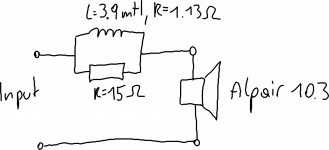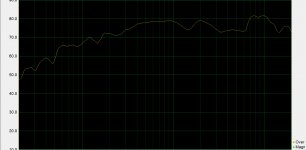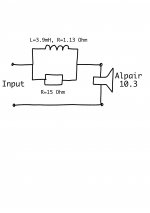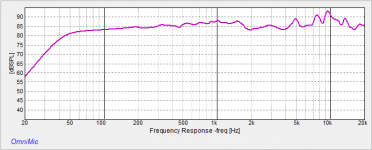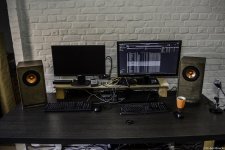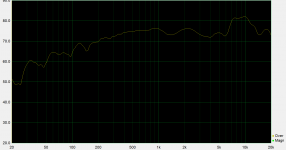After a long audio absence, I was curious to build a simple vented or closed bookshelf speaker with a fullranger for my office.
I was lucky to get a pair of Alpair 10.3 cheaply from ebay, so my starting point was this simple box which you can find on MarkAudio's website
http://wodendesign.com/downloads/simpleReflex-103-10p-plan-100214.pdf
Now putting a fullranger into a small box without any sort of filter won't give a neutral frequency response as the baffle step is not compensated.
While I respect MarkAudio's attitude of avoiding filters, this simple speaker design is pretty much unlistenable as it is all treble, with little midrange and no bass output - which is exactly what happens when the baffle step is not compensated.
After tinkering, building and listening to 4-5 different filter designs, I settled for a very simple RL-filter which - IMHO - works very, very well giving a neutral, balanced sound. Of course with such a filter one can only burn away energy, so the resulting speaker does not excel in efficiency.
I like the resulting sound a lot and thought I would share it here, so that others can try it too.
A note on bass: this speaker has decent bass output and I'm personally not missing anything in this regard. I know that the measurement might convey a different picture and one might be tempted to further attenuate mid and high range in favor for more bass.
However, my personal opinion is that full rangers should not carry the load of hefty bass output anyway. The required excursion for low frequencies doubles with every octave going down, which means that the full ranger works at least twice as hard at 50 Hz than at 100 Hz. The result is a strong increase in distortion - which can reach 10% for some transducers. If more bass output is needed I would opt to add a subwoofer and cross it with the fullranger at 100 Hz or so.
As the linked, initial filter-less speaker design is called simple bookshelf design, I termed my variant a quite simple bookshelf design.
Enjoy this little fun speaker, Hannes
PS: attached is a periodic white noise on-axis measurement 10cm from the cone away, 50 averages taken. My measurement chain is not calibrated, so values might not be fully accurate but should give an impression.
I was lucky to get a pair of Alpair 10.3 cheaply from ebay, so my starting point was this simple box which you can find on MarkAudio's website
http://wodendesign.com/downloads/simpleReflex-103-10p-plan-100214.pdf
Now putting a fullranger into a small box without any sort of filter won't give a neutral frequency response as the baffle step is not compensated.
While I respect MarkAudio's attitude of avoiding filters, this simple speaker design is pretty much unlistenable as it is all treble, with little midrange and no bass output - which is exactly what happens when the baffle step is not compensated.
After tinkering, building and listening to 4-5 different filter designs, I settled for a very simple RL-filter which - IMHO - works very, very well giving a neutral, balanced sound. Of course with such a filter one can only burn away energy, so the resulting speaker does not excel in efficiency.
I like the resulting sound a lot and thought I would share it here, so that others can try it too.
A note on bass: this speaker has decent bass output and I'm personally not missing anything in this regard. I know that the measurement might convey a different picture and one might be tempted to further attenuate mid and high range in favor for more bass.
However, my personal opinion is that full rangers should not carry the load of hefty bass output anyway. The required excursion for low frequencies doubles with every octave going down, which means that the full ranger works at least twice as hard at 50 Hz than at 100 Hz. The result is a strong increase in distortion - which can reach 10% for some transducers. If more bass output is needed I would opt to add a subwoofer and cross it with the fullranger at 100 Hz or so.
As the linked, initial filter-less speaker design is called simple bookshelf design, I termed my variant a quite simple bookshelf design.
Enjoy this little fun speaker, Hannes
PS: attached is a periodic white noise on-axis measurement 10cm from the cone away, 50 averages taken. My measurement chain is not calibrated, so values might not be fully accurate but should give an impression.
Attachments
Measured 1m response of this design sans filtering below. This was taken a couple of years ago & I don't have any more data -I've lost a fair bit due to an HDD failure (Yes, I know: I should back up  ); as I recall it was hard splice to the nearfield @200Hz, & something like a 4ms gate window but don't quote me on that.
); as I recall it was hard splice to the nearfield @200Hz, & something like a 4ms gate window but don't quote me on that.
Attachments
I suspect you did not run in the driver like is mentioned. It's very sharp when new but run it in for 100h and it becomes balanced.
I did also use it in a bookshelf, and it's a great speaker. I also use a small filter, but even without, when the driver is run in, it's great.
my design (including filter) is found in attachment.
I did also use it in a bookshelf, and it's a great speaker. I also use a small filter, but even without, when the driver is run in, it's great.
my design (including filter) is found in attachment.
Attachments
I found an measurement of an early filter design where I tried a small bandwidth notch filter - it is not fully without filter, but the filter has only a limited impact in a narrow frequency range.
It can be seen quite clearly that midrange output steadily decreases from 400Hz or so downward. Also there is a strong almost 10dB peak at 10kHz.
It can be seen quite clearly that midrange output steadily decreases from 400Hz or so downward. Also there is a strong almost 10dB peak at 10kHz.
Attachments
No, that is normal with Mark Audio drivers, they use rather special cone material (an airspace type of copper alloy) and a spider that need to loosen up. This is rather standard. Wait untill you're 100h far on the driver to judge like recommended by Mark Audio. They change a lot during that period, and after they do sound very balanced and detailed without being piercing sharp.
The filter i use is really fine tuning, without it it also sounds good after run in.
The filter i use is really fine tuning, without it it also sounds good after run in.
Sure, all drivers need some time to settle, but 20h or so is usually more than enough and currently the drivers have certainly 20-30h on them.
100h is an extreme number which is a bit hard to believe, but I'll keep that in mind.
Usually being the operative term, here.
100h is an extraordinarily long break in, but we're talking about drivers that are seeking to do extraordinary things and use out of the ordinary materials and construction to do them. Let them play constantly at low volume for about a week, turning the volume up a bit for the last day or so so you get a couple mm of excursion during the loudest passages. I now have 6 MA drivers working in my speakers and the difference between day 1 and day 6 of break in has been unsubtle.
100h is an extreme number which is a bit hard to believe, but I'll keep that in mind.
The older Mark Audio drivers require a gentle "break-in" for at least a 100 hours. This recommendation comes direct from the manufacturer and is important to follow. As a new MA owner it's understandable that you may not be aware of this.
FYI,many if the newer MA drivers don't require this extended period of "break-in".
jeff
Just built a set of micro towers with MA Pulvia 7HD drivers. Once the cabinets had three sides glued together I mounted the drivers and clamped on the last side. They were played as long as possible each day for over two weeks. Low volume only. When they were first turned on the drivers were easy to locate by ear and seemed to have more high frequency output than the CHP speakers they replaced. After several days I though something was wrong as the speakers seemed to have disappeared . I could no longer locate the individual drivers by ear. The high frequency output had changed in relation to the overall frequency response. It was quite remarkable and it was around 100 hours.
Did not hurt to do this. You may want to try it.
Did not hurt to do this. You may want to try it.
There might be a small misunderstanding here - I understand running-in this driver might be particularly important.
However, the filter I posted is not a small, detail correction (like a notch) - contrary, it is a MASSIVE correction, it is a low-pass shelving filter, starting to attenuate the driver above 100Hz and attenuating everything above 500Hz to about 30% of its original value - see attached transfer function.
This is a fundamental manipulation and I cannot imagine that running-in the driver is able change all of this.
As many of you are apparently very happy with this speaker without any filter, I can only assume that mine are out-of-spec or something like that.
However, the filter I posted is not a small, detail correction (like a notch) - contrary, it is a MASSIVE correction, it is a low-pass shelving filter, starting to attenuate the driver above 100Hz and attenuating everything above 500Hz to about 30% of its original value - see attached transfer function.
This is a fundamental manipulation and I cannot imagine that running-in the driver is able change all of this.
As many of you are apparently very happy with this speaker without any filter, I can only assume that mine are out-of-spec or something like that.
Attachments
My speakers are not finished and have not been used in the intended room so I don't know if I like them yet. Just posted that the overall frequency response seemed to change after break in. Maybe it didn't change and I just became used to them, however it was recommended by the manufacturer and it did not seem to cost much to implement.
I have run-in the drivers for 8h or so. Without any run-in, of course, it really sounds scary.
You have moved to filters far too easy. The A10.3 requires a larger than normal break-in. A gentle first 100 hrs to get them mostly right but another 400 hrs or so to meet their potential. Bas simproves dramatically and the top tends to smooth out as well as greater amounts of small information.
I do hope you have pushed them too hard too soon. That can give the suspension a “memory” you do not want.
A filter BSC is also a can of worms, by its very nature adding as many problems as fixes. It need sto be very judicious.
But get 100 hrs on them before you do anything.
dave
...so is usually more than enough and currently the drivers have certainly 20-30h on them.
A10.3 is not a usual driver.
dave
FYI,many if the newer MA drivers don't require this extended period of "break-in".
The mono suspension units. They do not have a spider to break in and that is the part that needs most of the breeak-in.
dave
... and I cannot imagine that running-in the driver is able change all of this.
Come back after 100 hrs.
Some people still want some compensation. But it will be much smaller.
I have never had to use an explicit BSC filter in any of the (close to a hundred i guess) of MA speakers we have built.
dave
- Status
- This old topic is closed. If you want to reopen this topic, contact a moderator using the "Report Post" button.
- Home
- Loudspeakers
- Full Range
- A quite simple bookshelf speaker with the Markaudio Alpair 10.3
